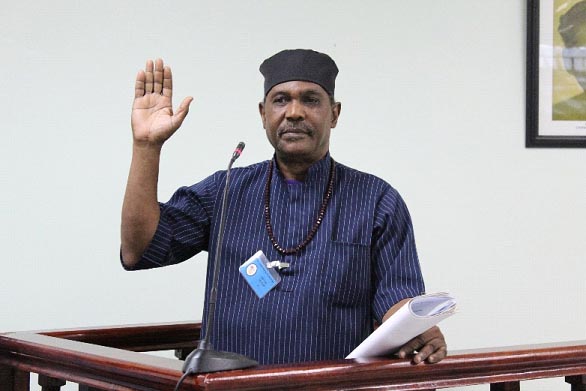The Guyana Sugar Corporation (GuySuCo) and the Guyana Water Incorporated (GWI) should repay the descendants of enslaved and manumitted Africans by offering lands and paying royalties, in compensation for the benefits they reaped from slave labour, Noah Yahshuarun, leader of the Descendants of Enslaved and Manumitted Africans of Guyana, has stated.
Yahshuarun made his case on Monday before the commission of inquiry (CoI) established to investigate African Ancestral lands at the Guyana Lands and Surveys Commission.
His testimony was a continuation of a presentation he made on August 21st.
“This is simple and straightforward: approximately 500 plantations were laid out by our African ancestors without any form of payment whatsoever. GuySuCo is the chief inheritor and beneficiary of these plantations and have earned huge profits from their use,” Yahshuarun stated.
As it relates to GWI, the man stated that Africans dug the Lamaha Canal from Mahaicony on the East Coast of Demerara to Land of Canaan on the East Bank of Demerara, and so GWI should pay royalties to the descendants for the use of it.
“The Guyana Water Incorporated and its predecessors have and continue to utilise and sell water from this canal and have made and is making huge profits from the sale of said water,” he added.
Yahshuarun stated that he would like his presentation to be viewed within the light of witness Dr Kimani Nehusi’s testimony before the commission. Nehusi had stated that lands were ancestral because they had been “humanised” by the Africans through certain acts such as the burial of the dead and the burying of navel strings and placentas.
It is in this vein that he asked that the above mentioned lands, worked by enslaved Africans, be regarded as ancestral lands.
Other recommendations given to the CoI included compensation for land lost during the conversion from plantation to village.
Yahshuarun stated that during this conversion, a Board of Villages was established, and this body was granted the authority to declare what plantations should be declared villages and to vary the boundaries of said villages.
He said that it was during this process that lands were lost.
“This is how many of our plantations including Mocha on the East Bank of Demerara and Buxton and Friendship and others on the East Coast of Demerara and elsewhere were made into villages, were lost, were varied in boundaries and were subjected to the other dictates of the Board of Villages without any compensation whatsoever. When our ancestors challenged the decisions of the board and refused to pay taxes to it, their properties were put for execution sale and were bought by others,” he stated.
What should be the reparations for this loss? That additional lands “totaling two hundred times the size of Victoria Village be given to descendants of enslaved and manumitted Africans as compensation for the lost plantations and the other effects of this ordinance on our people,” he said.
Additionally, the witness recommended that additional lands and money also be given to the descendants of enslaved and manumitted Africans as compensation for the loss of land transports, as he noted that the only transport available today for the plantations that were purchased is for Friendship as the others were misplaced or burnt.
“The loss of these transports represents the loss of our people’s ability to mortgage, sell and to otherwise deal financially/beneficially with these plantations which are valued at billions of dollars today and are their transported properties,” Yahshuarun said.
